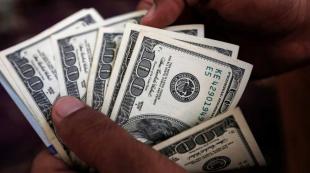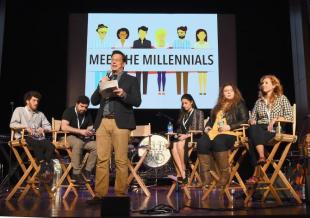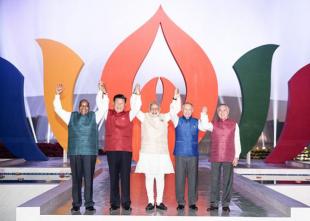JOURNAL | GLOBAL PERSPECTIVES By: Walter C Clemens Jr
History yields no precise repeats or lessons for current problems. Still, the 1962 Cuban missile crisis provides some parallels to today’s confrontation between North Korea and the United States. It also offers a bevy of suggestions – both dos and don’ts – to prevent the present confrontation from escalating into a major war.
The starting point for analysis is “Essence of Decision: Explaining the Cuban Missile Crisis,” by Graham Allison (1971), updated by Allison and Philip Zelikow in 1999. To explain any interaction between states, they wrote, requires that we study not only each side’s rational calculation, but also how their bureaucracies operate and how internal politics shape decisions. Thus, Soviet leader Nikita Khrushchev probably calculated that deploying medium-range missiles in Cuba could match US missiles in Turkey and compensate for a growing US lead in strategic delivery vehicles. But his hope to surprise the administration of US President John F Kennedy with a fait accompli was ruined by lack of coordination by each branch of the Soviet Armed Forces and by their habit of configuring medium-range missiles in a pattern that tipped off US observers. Neither in Moscow nor in Washington was there anything resembling “monolithic” policy-making, due to political infighting and the habit of each bureaucracy to follow its standard operating routine. In 1962, there was little political competition within the Kremlin but a great deal in Washington, where Kennedy feared Republican accusations of naiveté and weakness.
Each of these modes of explanation helps also to explain current North Korean and US behavior. Kim Jong-un probably calculates that a thermonuclear ICBM capability will compensate for other North Korean weaknesses and ensure the security of his regime and state. Kim has surely intimidated any dissent, but some elements of his bureaucracy may resent the heavy allocation of state resources to strategic weapons. “We already deter outside attack with our artillery and rockets aimed at Seoul,” some may think (if not say). Outsiders know very little about political competition in Pyongyang, but political rivalries in Washington are manifest – not only between but also within the two main parties and even inside the White House.
While the three kinds of explanation put forward by Allison and Zelikow are necessary, they are not sufficient. They neglect the individual psychology and behavior patterns of each leader, along with the peculiar political culture from which that leader emerged. No explanation of Cuba in 1962 can omit Khrushchev’s proclivity to gamble with little attention to possible dangers, nor the political culture that permitted the top leader to make risky decisions based on his own impulses. While we know little of Kim’s mind, his decisive actions against potential internal rivals demonstrate a ruthless addiction to the “Who will destroy whom?” (kto kovo?) syndrome of Soviet politics. Not only the more aggressive facets of Communist ideology but also the risk-taking bias attributed to Korean Confucianism shape the behavior of North Korean leaders.
Into this mix, US President Donald Trump is no less narcissistic than Kim Jong-un. Both leaders talk in extreme terms, but their actions on the world stage have been somewhat cautious. Their bark has been stronger than their bite, and in fact the two leaders may hold an unprecedented summit as early as May, if all goes well. Nicholas Kristof, the New York Times columnist, however, found in autumn 2017 that virtually all North Koreans expected war with the United States and believed they would prevail. Trump’s hard-core supporters, perhaps 40 percent of US voters, seemed to endorse his “fire and fury” orientation, even as many purchased more and more guns, ostensibly for personal defense.
Possible lessons
Avoid provoking the other side by changing the balance of power. The Cuban crisis took place in the context of a US-Soviet cold war that dated back to 1945 at least and, in some ways, back to 1917. The competition intensified when Khrushchev warned “We’ll bury you” and “We are producing missiles like sausages.” Though Kennedy knew that Khrushchev’s claims were exaggerated, he opted in 1961 to expand America’s strategic triad – bombers, ICBMs and missiles under the sea – more numerous and superior to anything expected soon from Soviet factories. He also deployed nuclear weapons in Turkey and other NATO countries close to the USSR, for which there was no equivalent Soviet threat to the United States. While America’s military might looked ominous to Khrushchev, he thought the US president was irresolute and could be outmaneuvered and cowed.
Both Kim and Trump seem impressed but not intimidated by the other’s weapons of mass destruction. While North Korea’s nuclear arsenal is tiny compared to that of the United States, the idea that even one or two North Korean nukes could reach US targets evokes alarm from Guam to Los Angeles and Washington, generating calls for a preventive or pre-emptive war. Not only is Kim changing the balance of power, but he threatens to use his new weapons in response to almost any provocation.
Do not underestimate the other side. Based on precedent, American analysts thought the USSR would never risk deploying advanced weapons far from home. But Khrushchev, a bold gambler, bet that he could get away with it. He was taken aback by the sangfroid firmness displayed by the Kennedy White House. And while the Americans discovered the approximate dimensions of the Soviet medium- and intermediate-range missile deployment, they did not know about the Soviet tactical nukes that could have been fired if Kennedy had dispatched an invasion force.
Do not insult the other side. Many of Khrushchev’s words and gestures were insulting to Kennedy and his country. Fortunately, Kennedy kept his cool. But Kim Jong-un and Trump show little mutual respect (psychopathic “dotard” versus “little rocket man”) even as each threatens to destroy the other. Outsiders cannot know when one or both leaders, offended and pressured on all sides, might snap. It could be difficult for anyone to restrain their impulses.
Look for nonviolent ways to resolve the crisis. Kennedy looked for the least violent way to press the USSR to withdraw its missiles and decided on a quarantine. Yes, a blockade is an act of war, but no shots were exchanged. Still, a Soviet submarine commander, his communication links with the Soviet General Staff down, prepared to fire his nuclear-tipped torpedo at US surface ships, only to reconsider and surface instead.
Do not force the other side into a corner from which it cannot retreat without losing face. Develop a quid pro quo so that each side can claim victory. The Soviets withdrew their missiles but got a US promise not to invade Cuba. They also received an assurance, kept secret for more than a decade, that US missiles would be withdrawn from Turkey within six months. In sharp contrast, Donald Trump, the supposed dealmaker, in 2017 offered Kim nothing in return for nuclear disarmament. Like the Obama administration, Trump conditioned talks with Pyongyang on a North Korean commitment to denuclearization. Washington seemed not to consider low-cost incentives such as a peace treaty to replace the 1953 armistice; diplomatic recognition; or scaling back military training exercises with South Korean forces.
Be clear when communicating. At the height of the missile crisis, Khrushchev sent two disparate messages to Washington. One was tough, while the other provided an opening for a deal. Kennedy chose to ignore the first and respond to the second. Had he focused on the first, the confrontation would have become more intense.
Establish reliable communications. In 1962, Moscow and Washington lacked reliable communications networks, which increased the peril. After Attorney General Robert F Kennedy met privately with Soviet Ambassador Anatoly Dobrynin, the Soviet Embassy relied on a Western Union bicyclist to deliver a coded message to the Kremlin reporting on the US ultimatum and its proffered concession in Turkey. (Fortunately for humanity, Khrushchev decided to retreat even before the telegram arrived.) Recognizing how dangerous these gaps in communication were, the Kremlin and White House established a hot line in April 1963. Later, several US and Soviet leaders agreed to talk by telephone – a risky practice because of possible mistranslation and temper outbursts.
Seoul and Pyongyang have used a hot line at times, but North Korean officials have several times shut it down precisely when it was needed most. Rex Tillerson, the recently fired US secretary of state, has said that the United States communicates with North Korea through three channels. One of these is the North Korean mission at the United Nations, but each side may question whether the messages delivered by the other’s diplomats are authoritative. Pyongyang could even doubt whether Tillerson’s assurances would be endorsed by Trump. Since Trump sometimes contradicts even himself, even his own words also lack credibility.
Make the terms of any accord explicit. Diplomats are tempted to obscure disagreements with vague generalizations, but failure to address all remaining issues often backfires. The understanding that resolved the 1962 crisis was never written down and signed by each side. Instead, it was based on unilateral statements by Khrushchev and Kennedy. To Moscow’s surprise, Washington meant the deal to apply to Soviet bombers as well as missiles, and – later – to include service stations for Soviet missile-carrying submarines. If Moscow did not go along with Washington’s interpretations, the United States might have felt entitled once more to invade Cuba.
Many of the putative accords between Washington and Pyongyang have been dangerously ambiguous. Did the 1994 Agreed Framework apply to uranium enrichment as well as plutonium production? Did the accords reached during the Six-Party Talks allow the United States to raise the bar by demanding on-site inspection at any stage of implementation? Did the 2012 Leap Day Agreement ban testing of “space rockets” as well as “missiles”? In each case, US negotiators were tempted to rely on what they told North Korean diplomats or on previous accords presumed still to be binding (such as the 1992 DPRK-South Korean denuclearization accord). Pyongyang may not be enthralled by legalisms, but it has often exploited the slightest ambiguity in treaty language.
Do not regard small players as mere tools of larger ones. Fidel Castro and his brother Raul were not mere pawns of the USSR. The Castro brothers, like the two Koreas, were dependent in some ways on their great-power patron but also had a mind and interests of their own. When Soviet missiles were withdrawn, Havana refused to admit international inspectors. To verify the missiles’ withdrawal, the superpowers resorted to displaying for US cameras the missiles lashed to the deck of Soviet ships.
Moscow manipulated Cuba and embarrassed Castro. Trying to assuage Castro’s hurt feelings after the crisis, Soviet First Deputy Prime Minister Anastas Mikoyan told him: “It’s all right to deceive enemies.” With friends, however, “sincerity and openness” are necessary to “resolve differences and reach a consensus. With enemies things are different.” But then, Mikoyan lied to Castro as well, implying that Moscow’s only goal had been to protect Cuba. Fidel later said that if he had known the Soviets were thinking about how to improve the balance of power, and how few missiles they had in 1962, he would have “advised them to be more prudent.”
Since the late 1940s, Washington has often treated North Korea as a Soviet or Chinese pawn. In recent decades, at least three US presidents have assumed that China could rein in North Korea’s weapons programs. Doubting North Korean technical and industrial abilities, some Americans have assumed that North Korea’s nuclear and missile achievements have depended on human or material inputs from outside – from China, the erstwhile Soviet empire or Pakistan. It may take years to learn the extent of outside help, but the evidence shows that all putative Communist comrades said “nyet” when Pyongyang asked for advanced nuclear know-how in the years before the Soviet collapse. Kim and his regime need Chinese oil and other forms of support, but have defied Beijing in developing and testing weapons of mass destruction. If Beijing tightens many screws on North Korea, it might reach a point that could cause Pyongyang to buckle. So far, this has not happened. The United States and other outsiders can’t assume that China or Russia can bring the North Korean leadership to its knees.
Do not count on a science of crisis management. Some observers said that Kennedy and his top advisers successfully stepped back from the brink due to their skills at crisis management. Several years after the crisis, however, Kennedy’s secretary of defense, Robert S McNamara, told a group of Harvard professors not to trust in tools of crisis management. What avoided Armageddon, he said, was luck. While McNamara probably overstated the case, the fact remains that much can go wrong when two rival powers challenge each other head-on. The nations that went to war in 1914 understood one another much better than do Washington and Pyongyang. They were also deeply interdependent in many ways. Still, nervous about who would strike first, how and where, they marched into disaster.
Kim today, like Khrushchev in 1962, appears ready to risk bold moves, and he faces even fewer domestic restraints than did the Soviet leader. If Kim felt his regime were collapsing from within or from external pressure, he might take desperate steps. No one should play “chicken” with such regimes. Had the Soviets not veered away in 1962 but instead detonated just one hydrogen bomb over US cities, few Americans would have applauded Kennedy’s firmness. Americans soon learned to live with a far larger Soviet missile threat than the force Khrushchev tried to deploy in 1962.
Guidelines for crisis
Here are 10 guidelines for decision makers in Washington and, adapted to different circumstances, in Pyongyang:
Pursue mutual gain and openness. Even with strong rivals, explore conditional cooperation buttressed with safeguards. Better to compromise and create joint values than retreat or march toward war.
Blend firmness and flexibility, potential punishment and reward. Be sure your strength is evident and credible, but do not bluster needlessly. Consider what the changing balance of power means for potential foes as well as for yourself. Be aware how hard it is to communicate. A bullheaded Khrushchev may have read conciliatory gestures as weakness and ignored stern warnings. Only when Kennedy blockaded Cuba did Khrushchev get the message.
Strive to see yourselves as others see you. Had the Kennedy team seen itself through Khrushchev’s eyes – as materially strong but irresolute – Washington might have predicted Khrushchev’s gamble.
Expect surprise. Beat down preconceptions and wishful thinking. Investigate how worst-case and unlikely scenarios might unfold. Ask if rationality and value for the other side may differ from how you see them.
Expect duplicity but try to prevent it. Lies can be expected certainly from foes who endorse any means to their ends. Lying was part of the Soviet operational code. Do not trust assurances, especially those using ambiguous terms such as “defensive” weapons.
Avoid stereotyping others. Understand that they may change. Khrushchev became a sober statesman as the 1962 crisis evolved. Had Kennedy typed Khrushchev once and forever as a cheat, give-and-take negotiations would have been unthinkable.
Know that things often go wrong. Do not count on good fortune.
Distance major foreign policy issues from partisan politics. Republicans and Democrats joined forces to organize the United Nations, the Marshall Plan and NATO; their rivalry helped kill the League of Nations in 1919 and set the stage for the 1962 crisis. One Republican president helped to kill the Agreed Framework in 2001-03 along with prospects for a wider agreement. Another Republican fueled tensions with Pyongyang to near breaking point in 2017.
Learn. Do not make the same mistakes twice. But do not learn the wrong lessons. Review assumptions and standard operating procedures to cope with change. Decide beforehand what evidence would count for or against your expectations. Weigh competing hypotheses. Integrate new data methodically with your existing beliefs. If an event comes as a surprise, re-evaluate your expectations. Discuss misjudgments internally and perhaps with the other side.
Do not merely adapt to circumstances but seek deeper learning and new solutions. It is easier to adjust tactics than to make substantive changes. After the Cuban crisis, both sides modified their behavior to avoid more collisions. Still, Soviet leaders also pledged: “Never again” – never again would they have to back down in the face of overwhelming US power. The Kremlin “learned” to intensify its arms buildup, a costly exercise that helped bring on the eventual collapse of the Soviet empire.
The wise response
A wise leader needs confidence but not hubris; willingness to use force but only as a very last resort; tolerance for ambiguity along with an ability to act under uncertainty; an ability to obtain and absorb advice without producing paralyzing splits within his (or her) team. A wise leader needs both memory and openness: without memory, he or she is like driftwood in the streams of life; without openness, like a bullet fired on an unchangeable path.
Given the lethality and long reach of modern weapons, a wise government will cultivate a strategy of preventive diplomacy. Crisis prevention beats crisis management. It seeks to ameliorate underlying problems so that potentially violent confrontations do not arise.
The main lesson from 1914 and from 1962 is: Don’t play with fire.
Walter C Clemens Jr is an associate at Harvard University’s Davis Center for Russian and Eurasian Studies and professor emeritus of political science at Boston University. This essay first appeared in Global Asia, a journal of the East Asia Foundation, with which Strategic Review has a content–sharing agreement.
 US tax reform: Big controversy but bigger yields
US tax reform: Big controversy but bigger yields  'Never apologize, never explain' and other bad ideas for working with millennials
'Never apologize, never explain' and other bad ideas for working with millennials  The united [`non-Western`] states of the world
The united [`non-Western`] states of the world